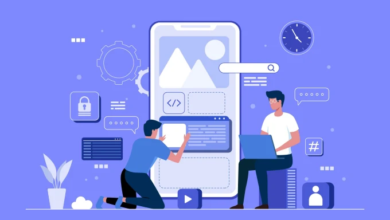From Code to UX: Top 10 Ways to Use AI in Web Development

The area of computer science known as artificial intelligence is where machines are given the ability to carry out jobs that were formerly only possible for humans. Artificial Intelligence has emerged as the basis of technological modernization, capable of learning from large datasets and solving complicated issues. Recent advances in natural language processing, machine learning, and neural networks have taken artificial intelligence to new heights, transforming entire sectors and varying the perception of what is possible for machines.
Here are some important AI-related points:
Machine Learning: When computers learn from data without needing to be openly programmed, it is called machine learning. It can predict outcomes, spot patterns, and improve as they gather more data.
Deep Learning: It is a type of machine learning that uses complex neural networks with many layers. It has been a game changer for things like recognizing speech, understanding images, and processing language.
Natural Language Processing: This lets machines understand and generate human language. It is used for things like analyzing feelings in text, translating languages, and creating chatbots.
Computer Vision: AI can now understand and analyze visual information from images and videos. This helps in tasks like self driving cars, identifying objects, and recognizing faces.
How has AI changed web development, and what exact features of user experience and efficacy does it improve?
AI has improved user experience on websites and made web development construction more efficient. Individual tastes are catered to via AI systems such as personalized content recommendations and interactive chatbots. Additionally, they aid in improving a website’s search engine ranking, increasing its visibility and popularity. Conversational AI and voice search are examples of natural language interfaces that facilitate user interaction with websites. By forecasting user behavior, predictive analytics enhances marketing tactics.
AI also improves website security by seeing dangers and producing content on its own. By evaluating how quickly content loads and distributing it in the most effective manner, it improves user experiences. All things considered, AI improves web development by making it more safe, efficient, and customized.
Let’s examine the many ways that artificial intelligence is altering web development.
Automated Generation of Code:
Tools for automated code creation, like GitHub, Copilot, provide a major improvement in developer productivity. These tools rely on artificial intelligence to simplify the coding process. They offer intelligent code recommendations and generate code snippets based on the context. This helps developers save time on boring coding tasks, allowing them to focus on more composite problem solving and higher level decisions in building software.
By including AI into the coding process, developers can access new ideas and insights, which not only accelerate development but also increase the quality of the code produced. This boosts productivity and efficiency, leading to faster development cycles and more reliable software solutions. Eventually, it allows developers to work more effectively, improving both the speed and quality of their work.
Enhanced User Experience (UX):
The use of artificial intelligence is essential to improving user experience on websites. By examining activity and preferences of users, it assists developers in understanding what people want. Websites can be tailored using AI to meet the demands of individual users. AI can provide references for products or articles based on the past actions of users.
AI powered chatbots and virtual assistants also improve user experience. These chatbots can quickly assist users with tasks like making appointments or responding to inquiries. Users will find it easier to get the answer, which will increase engagement and loyalty.
Resourceful Testing and Debugging:
The process of testing and debugging online applications has been completely transformed by AI-driven testing solutions. These technologies find errors and inconsistencies more quickly and precisely than manual techniques because they automate testing processes and make use of machine learning algorithms. By ensuring better-quality websites before distribution, this lowers the possibility of problems and downtime following deployment. In the end, AI-driven testing solutions speed up the development cycle and increase overall efficiency by allowing developers to concentrate their time and resources on more important tasks.
Design Assistance:
AI helps with design by giving ideas on how to arrange things like colors, layout, and text based on what looks good and what people like. It looks at a lot of information to make suggestions quickly, which saves time for designers. Also, it helps designers know what’s popular and lets them work together easily. This makes it easier to create websites that look nice and make people happy.
Content Generation:
AI-powered content creation is revolutionizing web development and providing huge advantages to both content producers and designers. Developers may automate the production of a variety of content formats, including as blog posts, social media updates, product descriptions, and even chatbot responses, by using AI algorithms.
AI’s capacity to create excellent content fast and effectively is one of its main benefits in content creation. Massive volumes of data, such as user reviews, industry trends, and previously published content, can be analyzed by AI algorithms to produce interesting and pertinent text and graphics. This guarantees uniformity and coherence throughout all content while also saving designers and content creators time.
In conclusion, AI-driven content generation expedites the process of creating content, saving designers and content producers time and effort. Artificial Intelligence assures consistency, scalability, and creativity by automating the development of text and graphics. This improves the overall quality of content and increases user engagement.
Ethical Considerations:
When incorporating AI into web development, ethical issues are crucial. In order to eliminate prejudice in AI algorithms and guarantee that experiences that are exclusive or biased are not had, designers must exercise caution. Setting justice and inclusivity as a top priority is not only morally required, but also essential for preserving consumer trust and preserving company reputation. Designers may build AI-driven systems that offer fair experiences for all users and promote inclusivity and trust in the digital sphere by proactively addressing biases and putting mitigation methods in place.
User privacy:
Because AI-driven personalization relies heavily on user data, it creates privacy problems when incorporated into web construction. Strong data protection policies and getting user consent are necessary to allay these worries. To ensure compliance with privacy legislation and preserve user confidence, designers should place a high priority on clear data handling processes and providing users with control over their privacy settings.
Skill Enhancement:
AI revolutionizes skill enhancement in web development by enabling designers to achieve more with less expertise. It democratizes design through intuitive tools and automation, making it accessible to a wider audience. While challenging traditional roles, AI also augments professional designers’ capabilities, allowing them to focus on creativity and strategic decision-making.
In conclusion, AI-driven skill augmentation in web development challenges the conventional position of professional designers and democratizes design by making it more accessible to a wider audience.
Predictive Design:
Predictive design, driven by AI, dynamically adjusts interfaces based on user behavior, improving usability. By analyzing data like browsing history and preferences, AI predicts where users are likely to interact and adjusts button placement and content dynamically. This personalization enhances user satisfaction and accessibility, making web experiences more intuitive and engaging.
Collaboration, Not Replacement:
AI serves as a valuable tool for designers, automating repetitive tasks and providing insights. Rather than replacing human creativity, it empowers designers to focus on innovation and delivering better experiences in web development.
Conclusion
In summary, artificial intelligence (AI) is meant to complement human creativity in web development by hashlogics, not to replace it. At Hashlogics, we see the value of utilizing AI to improve user experiences, expedite procedures, and spur innovation. Collaborate with us to leverage AI-powered solutions for your web development endeavors and maintain a competitive edge.



